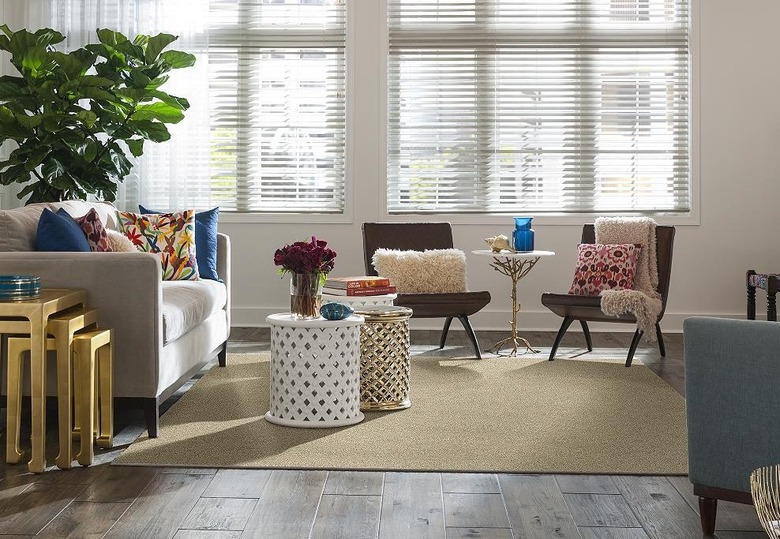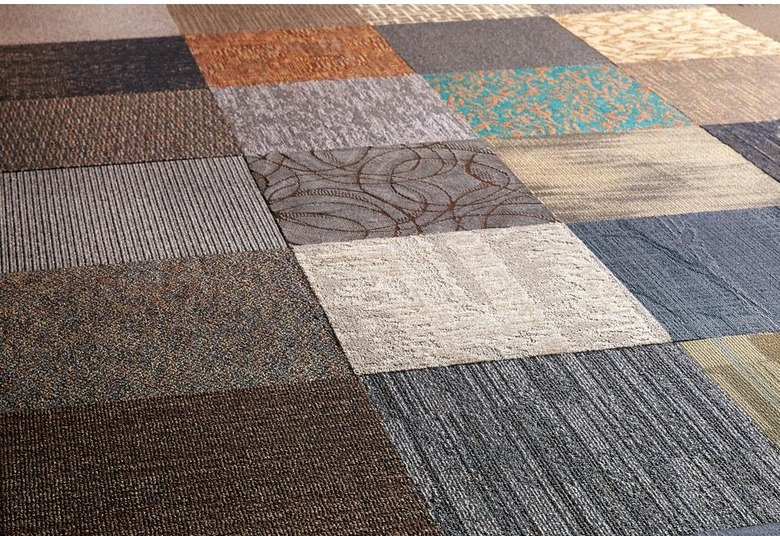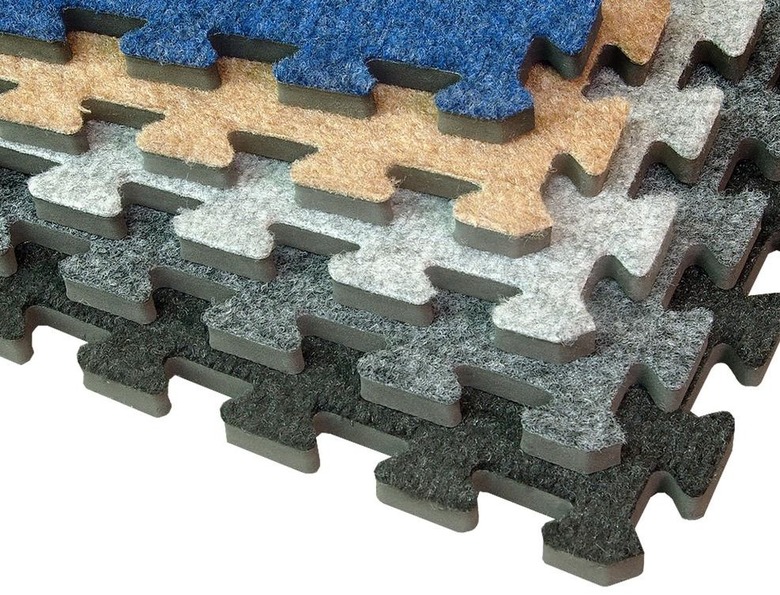Carpet Tiles: A Homeowner's Comprehensive Flooring Guide
Carpet tiles are enjoying a renaissance. Once glued down to the floors of airports and bowling alleys, new lines of tiles can be found everywhere from hip studios to elegant dining rooms. Available in a variety of fun colors and designs, they're easy to install and can be great options for people who want the warmth and comfort of carpet without the commitment of wall-to-wall carpeting. Learning more about their versatility and design options can help you determine if carpet tiles are an option for your house or apartment.
Carpet Tile: Then and Now
Carpet Tile: Then and Now
Throughout the 1970s and 1980s, carpet tiles were a staple in commercial spaces like airports and office buildings, thanks to being incredibly durable and relatively low maintenance. However, the styles tended to be a little outdated or unlike those you'd want in a house, and thinking of them may take you back to the neon patterns at the roller skating rinks or arcades of your youth. The older versions also typically required installation methods like gluing them down to the floor, making them more difficult to put in place or repair.
In recent years, manufacturers have begun to create carpet tiles designed for a new era of homeowners and renters. The new wave of carpet tiles was led by a company called FLOR, but carpet squares are now available from a wide variety of carpet retailers. The tiles are still durable and easy to maintain, but the colors and designs are now geared toward people who care about the look and feel of their living space.
In addition to coming in a wider variety of chic designs, today's carpet tiles are also far easier to install since most use simple adhesive to stick to the floor. This makes them great for people who rent their places and can't make permanent changes or those who want to invest in a type of carpeting that they can bring with them when they move to their next rental.
Pros of Carpet Tiles
Pros of Carpet Tiles
If you're considering carpeting for your home, there are many advantages that carpet tiles have over wall-to-wall carpeting:
- Durability: Carpet tiles are designed to be used in high-traffic areas and are typically super heavy-duty. They can withstand a lot of activity and usually require low-maintenance care like regular vacuuming.
- Easy to replace: If one area of your tile carpet gets stained or torn, you can simply replace the affected tile or tiles. That's unlike many types of flooring options such as hardwood, natural stone or wall-to-wall carpeting, for which repairs and replacements can be more expensive and lead to undesirable looks such as visible seams or a stone that doesn't exactly match.
- Take it with you when you go: You can't pick up a gorgeous hardwood floor or limestone tiles when you move out. However, most carpet tiles are designed to be mobile since many use just a non-damaging adhesive to make them stick to the floor. This makes them a great option for renters.
- Indoor air quality: Some people with allergies or asthma love the look and feel of wall-to-wall carpeting but don't consider it as an option since some types of carpeting can trap allergens and mold (especially when not cleaned properly), worsening the indoor air quality. Others are made of natural carpet fibers to which many people are sensitive, such as wool. Carpet tiles are a solution since many brands offer a wide array of tiles that are made from fibers like nylon and polyester to make them hypoallergenic. Most brands are also low in what the Environmental Protection Agency calls VOCs, or volatile organic compounds. Other types of carpeting or flooring installation processes can release harmful VOCs into the air, causing health issues like respiratory problems or eye irritation, but most carpet tiles are a cleaner option.
- DIY: Wall-to-wall or broadloom carpeting almost always requires professional installation, but putting in carpet tiles can be an easy do-it-yourself job for a home improvement project.
Cons of Carpet Tiles
Cons of Carpet Tiles
Carpet tiles can have their disadvantages too:
- It's still carpeting: For some people, the biggest disadvantage to carpet tiles is that it's still carpeting. Though many people prefer the look and feel of carpeting, some have rooms that are too prone to moisture. Others want to take extra measures to avoid allergens or want to avoid having to clean stained carpeting. If you have any of these concerns, you might be better off sticking to hard floors like tile, vinyl, laminate or hardwood.
- Potential for seams: Some people also prefer the look of wall-to-wall carpeting that comes in rolls since there are no visible seams. Although many carpet tile manufacturers try to create tiles without obvious seams or look at ways to incorporate those into visually pleasing patterns, it can still be a design turn-off for some.
- Cost: Prices of high-quality or aesthetically gorgeous carpet flooring initially deterred some buyers when residential carpet tile became more popular, as some tiles can cost as much as $12 or more per square foot. In recent years, though, more manufacturers have begun to unveil their own lines of tiles, with some as affordable as $1 to $3 per square foot. Carpet tile is still typically more expensive per square foot than broadloom carpeting, though installation costs can quickly add up to make tiles the cheaper option in the end.
Design and Versatility
Design and Versatility
Since they come in so many styles and can be easily moved or adjusted, carpet tiles are quite versatile. Several squares can be connected to make area rugs that are more durable and stick in place better than traditional non-tile rugs.
This can also offer people an area in which to get creative with the shape of an area rug. You could arrange the tiles in an interesting geometric pattern, or you could create a rug look where one color or design creates a border around another style of tile, potentially with some of the floor peeking through to allow for an interesting contrast between floor and rug. Especially creative DIYers can even buy several different colors of carpet tiles and cut and arrange them in all different shapes to make an area rug of their own one-of-a-kind design.
Carpet tiles are also great if you have an oddly shaped area you want to be carpeted. Wall-to-wall carpeting, which comes in rolls, is much harder to fit into nooks and crannies during installation, which leads to greater waste. With carpet tiles, which come in smaller squares, people can more easily fit squares into odd spaces or extend carpet tiles working as area rugs into hallways or on stairs.
They're also popular in playrooms or bedrooms for children since you can use certain patterns or bright colors the kids love but easily replace them as they outgrow those designs in a few years. Many parents also love that it's easier to clean or replace a single carpet tile than it is to get wall-to-wall carpeting professionally cleaned or treated, making it a good option for the kids' spaces that tend to get messy or stained easily.
Carpet tiles are also great for areas like basements. Carpeting is often preferable on hard and chilly basement floors. Basements can also be prone to flooding or other water damage, and completely tearing out and replacing wall-to-wall carpeting in the aftermath of that damage can be expensive and time consuming. Carpet squares, on the other hand, are an option that can be more easily and affordably repaired or replaced or more easily arranged in a way that keeps carpet away from the basement areas that are more prone to damage.
Choosing Your Carpet Tiles
Choosing Your Carpet Tiles
Just like with wall-to-wall carpeting, there are all kinds of decisions you must make when deciding what type of tiles you want. Most of these will depend on your personal preference or the needs of the room you'll be carpeting.
You can decide what kind of pile and fiber you want in your carpet tile. High-pile carpeting is the kind of longer fiber loop into which you can sink your hand, while low pile means that the fiber loops are shorter and closer to the ground. They can also come in a cut-and-loop pile design, which allows for more textured designs or a sculptured effect within the carpet square.
Just like broadloom carpet rolls, carpet tiles also come in a wide variety of fibers, including nylon, polyester, natural wools and olefin, a synthetic fiber designed to look and feel like wool. If you have allergies, nylon or olefin are your best options. Additionally, many people looking for the most environmentally conscious option opt for brands that make their tiles out of recycled materials, such as old carpet tiles or reclaimed nylon.
Carpet tiles also come with different types of backing, although there generally isn't as much variety between backings as there is with broadloom carpet tiles, especially when it comes to carpet tiles you'll use in your home. Most brands offer hardback backings including vinyl, recycled vinyl, fiberglass, urethane or woven polypropylene. Others offer cushion-backed tiles, which can be softer and protect the fibers longer, though the harder backs are usually better at preventing buckling and curling at the edges.
Carpet Tile Installation
Carpet Tile Installation
Ease of installation is one of the biggest advantages to using carpet tiles. It's a job you can easily complete yourself by following the manufacturer's suggestions.
One of the first things to keep in mind during the process is to allow your carpet tiles to acclimate to the room for at least 24 hours before you install them on the floor. All flooring is susceptible to changes in the climate, and allowing it to acclimate can prevent future expansions that will lead to an uneven or buckled look. This is especially important if you live in a humid climate. Take a look at the manufacturer's instructions to see how long it is recommended that you allow the tiles to sit before installation.
Another important step is preparing the floor beneath the carpet tiles for installation. Make sure it is clean and dry in order to make sure that the tiles can lie as flat and evenly as possible and that no moisture gets trapped underneath the tiles. Depending on the type of subfloor you have, you may need to do some sanding or grout removal to level the floor and guarantee an even installation.
Most carpet tiles come with some sort of adhesive sticker or tape that will help it bond to the floor. Take care to first arrange the tiles in the pattern of your choosing and to line them up as even and straight as possible. Press down firmly on the tile to help the bond grow immediately strong.
As dust and debris start to pile up, you can maintain them the same way that you would with wall-to-wall carpeting: by regular vacuuming or spot treatment for small stains. If stubborn stains persist, you can remove the tile to give it a more thorough cleaning, though make sure to check the manufacturer's instructions in case there are cleaning chemicals they suggest you avoid. These steps can help you enjoy your carpet tiles for years to come.
References
- United States Environmental Protection Agency: Volatile Organic Compounds' Impact on Indoor Air Quality
- BuildDirect: What are Carpet Tiles?
- FlooringAmerica: Hypoallergenic Carpet Options for Spring 2019
- Flooring Inc.: Carpet Tile Buying Guide
- Floor Covering Weekly: Carpet Tile Finds Its Way to Residential
- Modernize: Trend to Try: Carpet Tiles


